Tesco's Global Commerce: Factors, Challenges, and Strategies Report
VerifiedAdded on 2020/12/29
|18
|5824
|108
Report
AI Summary
This report provides a comprehensive analysis of Tesco's global commerce operations. It begins by identifying key factors driving global commerce and trade, including cost, competition, and environmental considerations. The report then delves into the complexity of strategic challenges faced by Tesco, such as promotional issues, pricing strategies, and import regulations. Furthermore, it explores the influence of globalization on organizational governance, leadership, structure, culture, and functions, along with the importance of ethical and sustainable practices. The report also evaluates effective decision-making processes in a global environment and examines various routes to internationalization for businesses. Finally, the report offers recommendations to overcome the strategic challenges, emphasizing the adoption of technology, market penetration strategies, and cultural sensitivity in promotional activities, providing a holistic view of Tesco's global strategy and operational landscape.

Paraphrase This Document
Need a fresh take? Get an instant paraphrase of this document with our AI Paraphraser
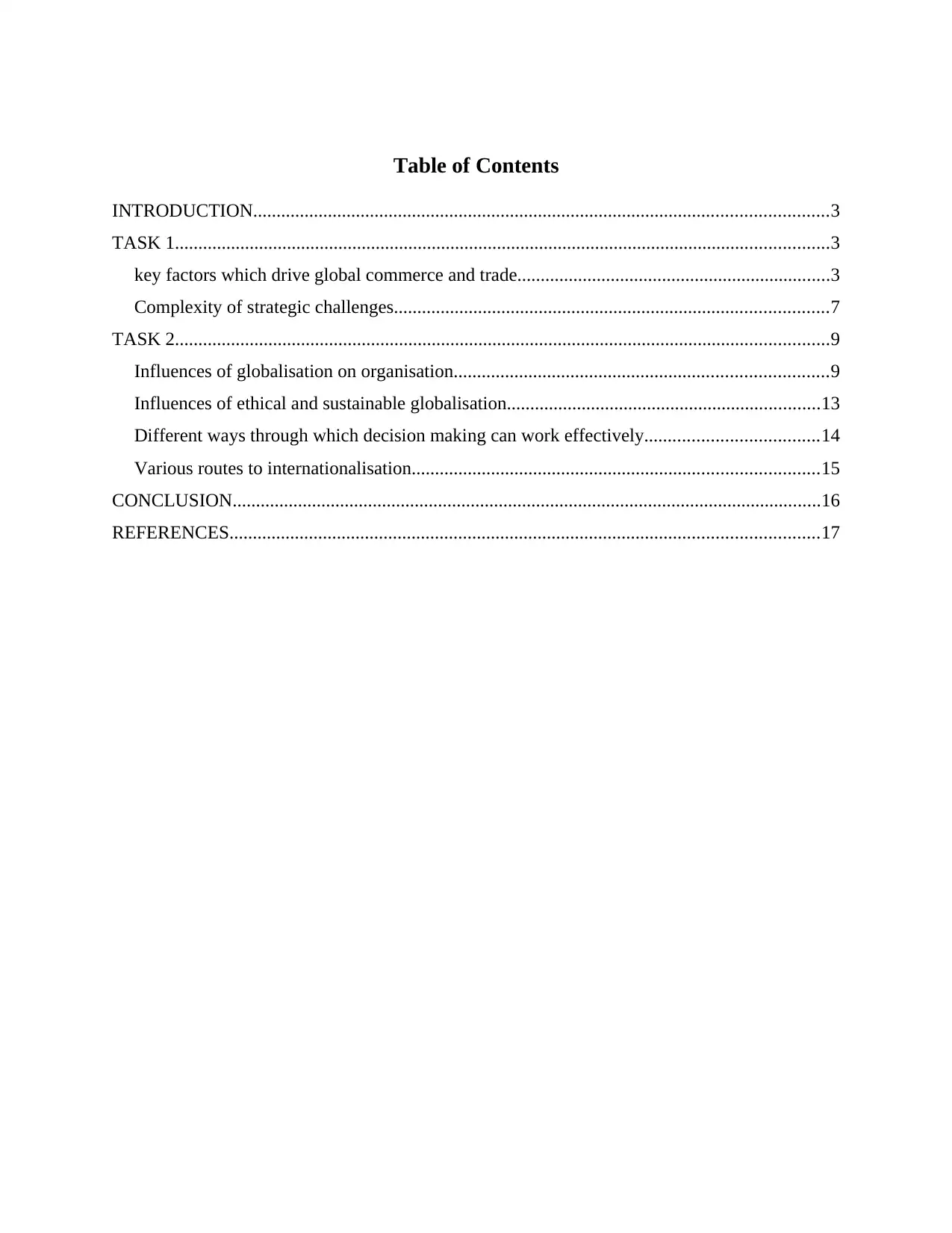
Table of Contents
INTRODUCTION...........................................................................................................................3
TASK 1............................................................................................................................................3
key factors which drive global commerce and trade...................................................................3
Complexity of strategic challenges.............................................................................................7
TASK 2............................................................................................................................................9
Influences of globalisation on organisation................................................................................9
Influences of ethical and sustainable globalisation...................................................................13
Different ways through which decision making can work effectively.....................................14
Various routes to internationalisation.......................................................................................15
CONCLUSION..............................................................................................................................16
REFERENCES..............................................................................................................................17
INTRODUCTION...........................................................................................................................3
TASK 1............................................................................................................................................3
key factors which drive global commerce and trade...................................................................3
Complexity of strategic challenges.............................................................................................7
TASK 2............................................................................................................................................9
Influences of globalisation on organisation................................................................................9
Influences of ethical and sustainable globalisation...................................................................13
Different ways through which decision making can work effectively.....................................14
Various routes to internationalisation.......................................................................................15
CONCLUSION..............................................................................................................................16
REFERENCES..............................................................................................................................17
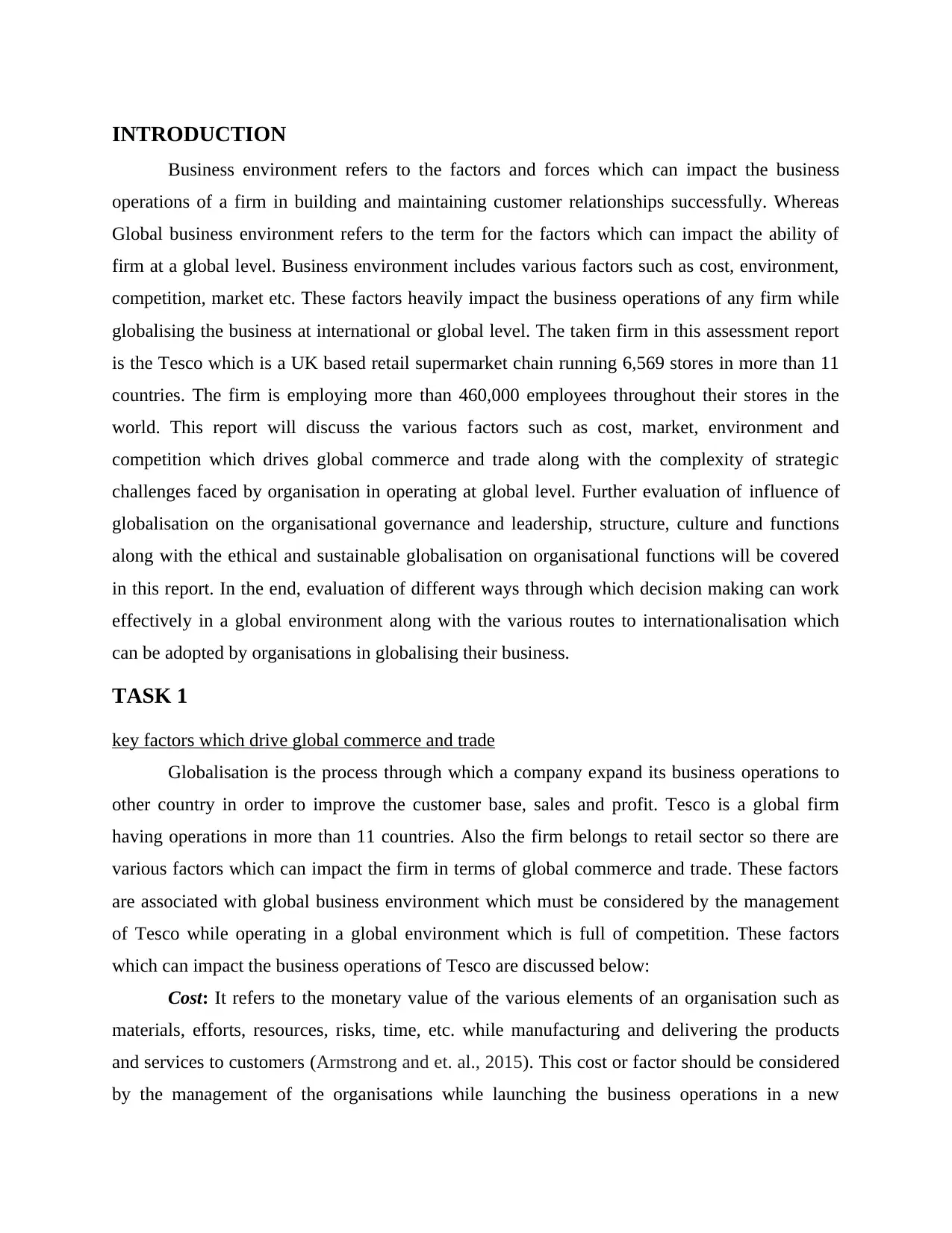
INTRODUCTION
Business environment refers to the factors and forces which can impact the business
operations of a firm in building and maintaining customer relationships successfully. Whereas
Global business environment refers to the term for the factors which can impact the ability of
firm at a global level. Business environment includes various factors such as cost, environment,
competition, market etc. These factors heavily impact the business operations of any firm while
globalising the business at international or global level. The taken firm in this assessment report
is the Tesco which is a UK based retail supermarket chain running 6,569 stores in more than 11
countries. The firm is employing more than 460,000 employees throughout their stores in the
world. This report will discuss the various factors such as cost, market, environment and
competition which drives global commerce and trade along with the complexity of strategic
challenges faced by organisation in operating at global level. Further evaluation of influence of
globalisation on the organisational governance and leadership, structure, culture and functions
along with the ethical and sustainable globalisation on organisational functions will be covered
in this report. In the end, evaluation of different ways through which decision making can work
effectively in a global environment along with the various routes to internationalisation which
can be adopted by organisations in globalising their business.
TASK 1
key factors which drive global commerce and trade
Globalisation is the process through which a company expand its business operations to
other country in order to improve the customer base, sales and profit. Tesco is a global firm
having operations in more than 11 countries. Also the firm belongs to retail sector so there are
various factors which can impact the firm in terms of global commerce and trade. These factors
are associated with global business environment which must be considered by the management
of Tesco while operating in a global environment which is full of competition. These factors
which can impact the business operations of Tesco are discussed below:
Cost: It refers to the monetary value of the various elements of an organisation such as
materials, efforts, resources, risks, time, etc. while manufacturing and delivering the products
and services to customers (Armstrong and et. al., 2015). This cost or factor should be considered
by the management of the organisations while launching the business operations in a new
Business environment refers to the factors and forces which can impact the business
operations of a firm in building and maintaining customer relationships successfully. Whereas
Global business environment refers to the term for the factors which can impact the ability of
firm at a global level. Business environment includes various factors such as cost, environment,
competition, market etc. These factors heavily impact the business operations of any firm while
globalising the business at international or global level. The taken firm in this assessment report
is the Tesco which is a UK based retail supermarket chain running 6,569 stores in more than 11
countries. The firm is employing more than 460,000 employees throughout their stores in the
world. This report will discuss the various factors such as cost, market, environment and
competition which drives global commerce and trade along with the complexity of strategic
challenges faced by organisation in operating at global level. Further evaluation of influence of
globalisation on the organisational governance and leadership, structure, culture and functions
along with the ethical and sustainable globalisation on organisational functions will be covered
in this report. In the end, evaluation of different ways through which decision making can work
effectively in a global environment along with the various routes to internationalisation which
can be adopted by organisations in globalising their business.
TASK 1
key factors which drive global commerce and trade
Globalisation is the process through which a company expand its business operations to
other country in order to improve the customer base, sales and profit. Tesco is a global firm
having operations in more than 11 countries. Also the firm belongs to retail sector so there are
various factors which can impact the firm in terms of global commerce and trade. These factors
are associated with global business environment which must be considered by the management
of Tesco while operating in a global environment which is full of competition. These factors
which can impact the business operations of Tesco are discussed below:
Cost: It refers to the monetary value of the various elements of an organisation such as
materials, efforts, resources, risks, time, etc. while manufacturing and delivering the products
and services to customers (Armstrong and et. al., 2015). This cost or factor should be considered
by the management of the organisations while launching the business operations in a new
⊘ This is a preview!⊘
Do you want full access?
Subscribe today to unlock all pages.

Trusted by 1+ million students worldwide
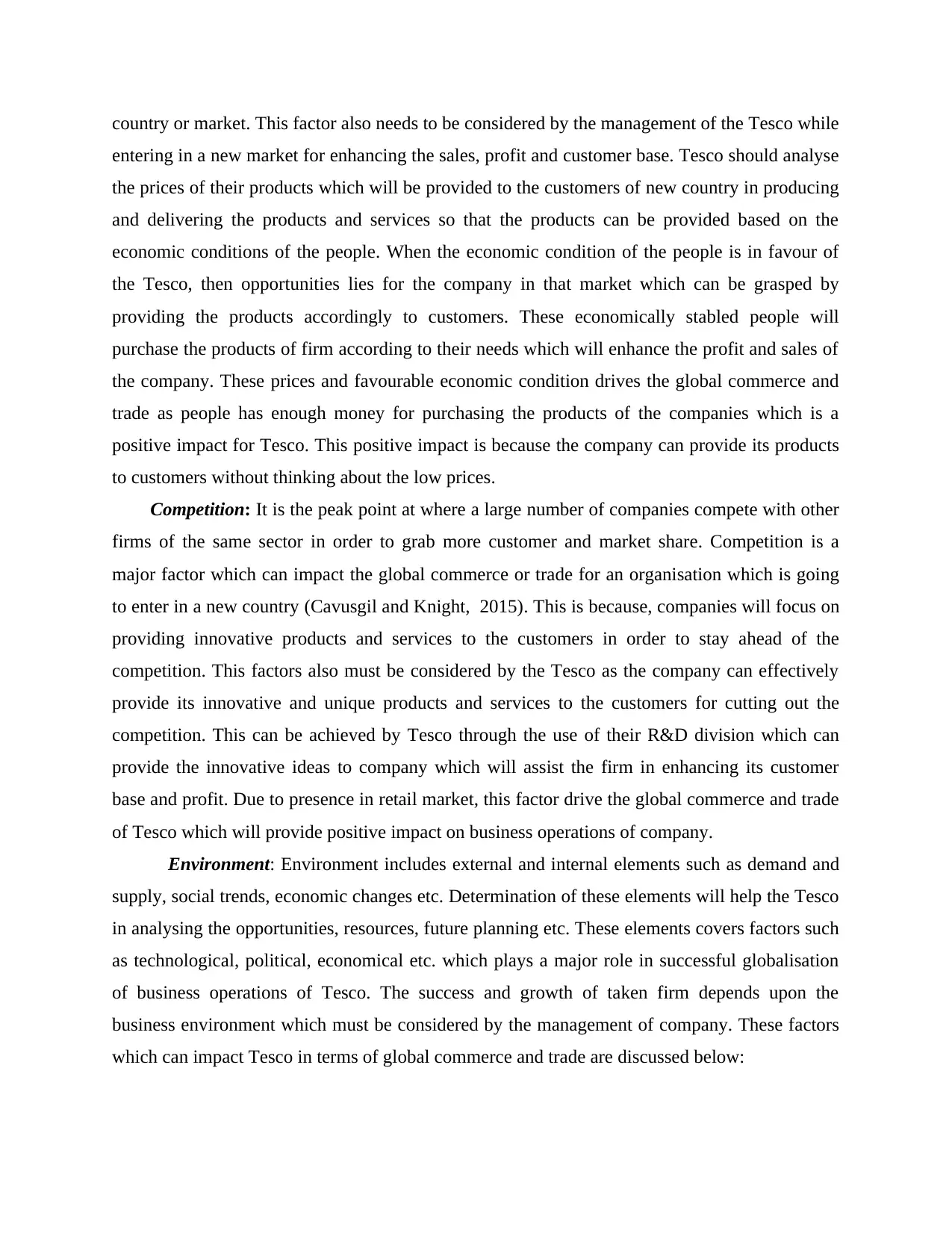
country or market. This factor also needs to be considered by the management of the Tesco while
entering in a new market for enhancing the sales, profit and customer base. Tesco should analyse
the prices of their products which will be provided to the customers of new country in producing
and delivering the products and services so that the products can be provided based on the
economic conditions of the people. When the economic condition of the people is in favour of
the Tesco, then opportunities lies for the company in that market which can be grasped by
providing the products accordingly to customers. These economically stabled people will
purchase the products of firm according to their needs which will enhance the profit and sales of
the company. These prices and favourable economic condition drives the global commerce and
trade as people has enough money for purchasing the products of the companies which is a
positive impact for Tesco. This positive impact is because the company can provide its products
to customers without thinking about the low prices.
Competition: It is the peak point at where a large number of companies compete with other
firms of the same sector in order to grab more customer and market share. Competition is a
major factor which can impact the global commerce or trade for an organisation which is going
to enter in a new country (Cavusgil and Knight, 2015). This is because, companies will focus on
providing innovative products and services to the customers in order to stay ahead of the
competition. This factors also must be considered by the Tesco as the company can effectively
provide its innovative and unique products and services to the customers for cutting out the
competition. This can be achieved by Tesco through the use of their R&D division which can
provide the innovative ideas to company which will assist the firm in enhancing its customer
base and profit. Due to presence in retail market, this factor drive the global commerce and trade
of Tesco which will provide positive impact on business operations of company.
Environment: Environment includes external and internal elements such as demand and
supply, social trends, economic changes etc. Determination of these elements will help the Tesco
in analysing the opportunities, resources, future planning etc. These elements covers factors such
as technological, political, economical etc. which plays a major role in successful globalisation
of business operations of Tesco. The success and growth of taken firm depends upon the
business environment which must be considered by the management of company. These factors
which can impact Tesco in terms of global commerce and trade are discussed below:
entering in a new market for enhancing the sales, profit and customer base. Tesco should analyse
the prices of their products which will be provided to the customers of new country in producing
and delivering the products and services so that the products can be provided based on the
economic conditions of the people. When the economic condition of the people is in favour of
the Tesco, then opportunities lies for the company in that market which can be grasped by
providing the products accordingly to customers. These economically stabled people will
purchase the products of firm according to their needs which will enhance the profit and sales of
the company. These prices and favourable economic condition drives the global commerce and
trade as people has enough money for purchasing the products of the companies which is a
positive impact for Tesco. This positive impact is because the company can provide its products
to customers without thinking about the low prices.
Competition: It is the peak point at where a large number of companies compete with other
firms of the same sector in order to grab more customer and market share. Competition is a
major factor which can impact the global commerce or trade for an organisation which is going
to enter in a new country (Cavusgil and Knight, 2015). This is because, companies will focus on
providing innovative products and services to the customers in order to stay ahead of the
competition. This factors also must be considered by the Tesco as the company can effectively
provide its innovative and unique products and services to the customers for cutting out the
competition. This can be achieved by Tesco through the use of their R&D division which can
provide the innovative ideas to company which will assist the firm in enhancing its customer
base and profit. Due to presence in retail market, this factor drive the global commerce and trade
of Tesco which will provide positive impact on business operations of company.
Environment: Environment includes external and internal elements such as demand and
supply, social trends, economic changes etc. Determination of these elements will help the Tesco
in analysing the opportunities, resources, future planning etc. These elements covers factors such
as technological, political, economical etc. which plays a major role in successful globalisation
of business operations of Tesco. The success and growth of taken firm depends upon the
business environment which must be considered by the management of company. These factors
which can impact Tesco in terms of global commerce and trade are discussed below:
Paraphrase This Document
Need a fresh take? Get an instant paraphrase of this document with our AI Paraphraser
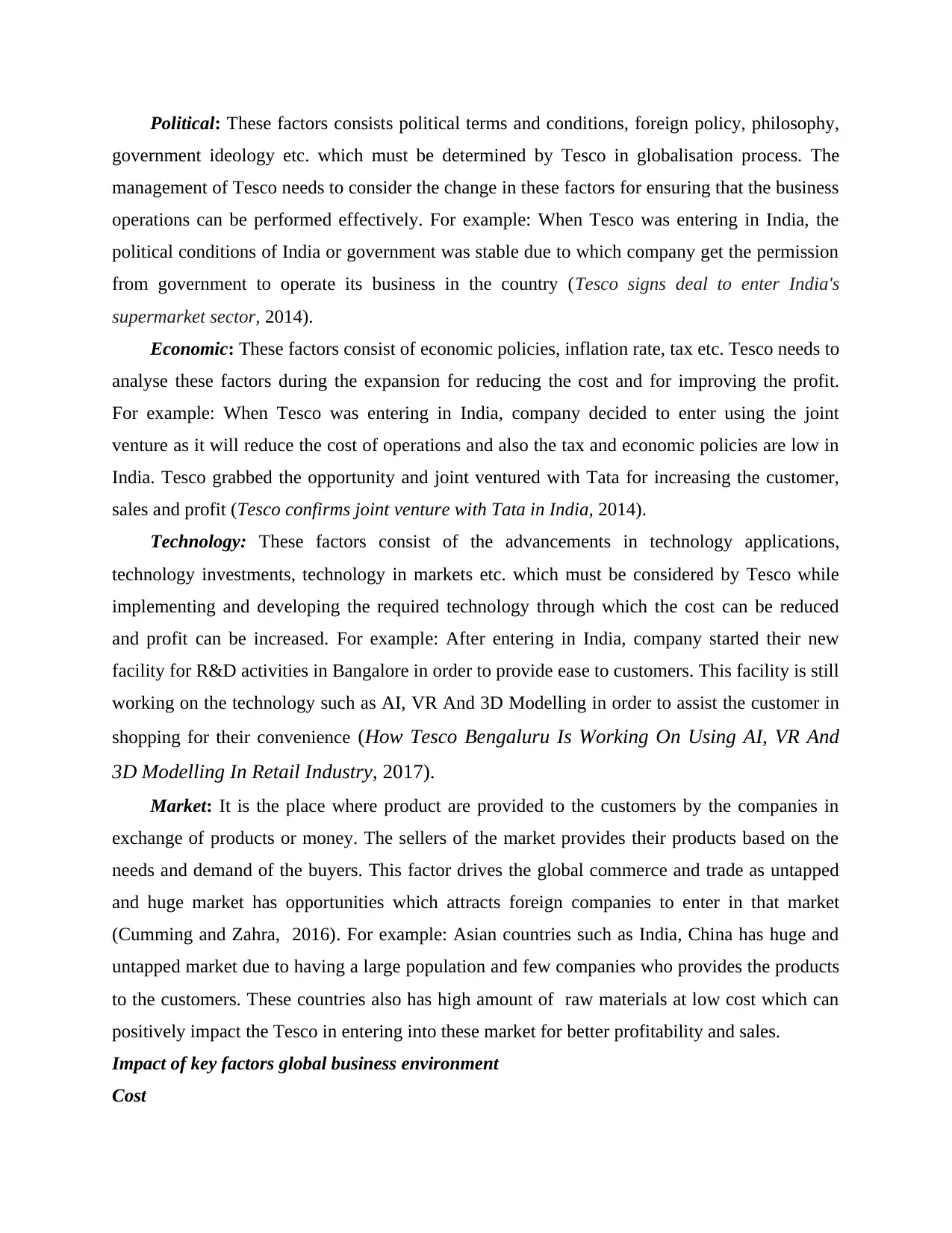
Political: These factors consists political terms and conditions, foreign policy, philosophy,
government ideology etc. which must be determined by Tesco in globalisation process. The
management of Tesco needs to consider the change in these factors for ensuring that the business
operations can be performed effectively. For example: When Tesco was entering in India, the
political conditions of India or government was stable due to which company get the permission
from government to operate its business in the country (Tesco signs deal to enter India's
supermarket sector, 2014).
Economic: These factors consist of economic policies, inflation rate, tax etc. Tesco needs to
analyse these factors during the expansion for reducing the cost and for improving the profit.
For example: When Tesco was entering in India, company decided to enter using the joint
venture as it will reduce the cost of operations and also the tax and economic policies are low in
India. Tesco grabbed the opportunity and joint ventured with Tata for increasing the customer,
sales and profit (Tesco confirms joint venture with Tata in India, 2014).
Technology: These factors consist of the advancements in technology applications,
technology investments, technology in markets etc. which must be considered by Tesco while
implementing and developing the required technology through which the cost can be reduced
and profit can be increased. For example: After entering in India, company started their new
facility for R&D activities in Bangalore in order to provide ease to customers. This facility is still
working on the technology such as AI, VR And 3D Modelling in order to assist the customer in
shopping for their convenience (How Tesco Bengaluru Is Working On Using AI, VR And
3D Modelling In Retail Industry, 2017).
Market: It is the place where product are provided to the customers by the companies in
exchange of products or money. The sellers of the market provides their products based on the
needs and demand of the buyers. This factor drives the global commerce and trade as untapped
and huge market has opportunities which attracts foreign companies to enter in that market
(Cumming and Zahra, 2016). For example: Asian countries such as India, China has huge and
untapped market due to having a large population and few companies who provides the products
to the customers. These countries also has high amount of raw materials at low cost which can
positively impact the Tesco in entering into these market for better profitability and sales.
Impact of key factors global business environment
Cost
government ideology etc. which must be determined by Tesco in globalisation process. The
management of Tesco needs to consider the change in these factors for ensuring that the business
operations can be performed effectively. For example: When Tesco was entering in India, the
political conditions of India or government was stable due to which company get the permission
from government to operate its business in the country (Tesco signs deal to enter India's
supermarket sector, 2014).
Economic: These factors consist of economic policies, inflation rate, tax etc. Tesco needs to
analyse these factors during the expansion for reducing the cost and for improving the profit.
For example: When Tesco was entering in India, company decided to enter using the joint
venture as it will reduce the cost of operations and also the tax and economic policies are low in
India. Tesco grabbed the opportunity and joint ventured with Tata for increasing the customer,
sales and profit (Tesco confirms joint venture with Tata in India, 2014).
Technology: These factors consist of the advancements in technology applications,
technology investments, technology in markets etc. which must be considered by Tesco while
implementing and developing the required technology through which the cost can be reduced
and profit can be increased. For example: After entering in India, company started their new
facility for R&D activities in Bangalore in order to provide ease to customers. This facility is still
working on the technology such as AI, VR And 3D Modelling in order to assist the customer in
shopping for their convenience (How Tesco Bengaluru Is Working On Using AI, VR And
3D Modelling In Retail Industry, 2017).
Market: It is the place where product are provided to the customers by the companies in
exchange of products or money. The sellers of the market provides their products based on the
needs and demand of the buyers. This factor drives the global commerce and trade as untapped
and huge market has opportunities which attracts foreign companies to enter in that market
(Cumming and Zahra, 2016). For example: Asian countries such as India, China has huge and
untapped market due to having a large population and few companies who provides the products
to the customers. These countries also has high amount of raw materials at low cost which can
positively impact the Tesco in entering into these market for better profitability and sales.
Impact of key factors global business environment
Cost
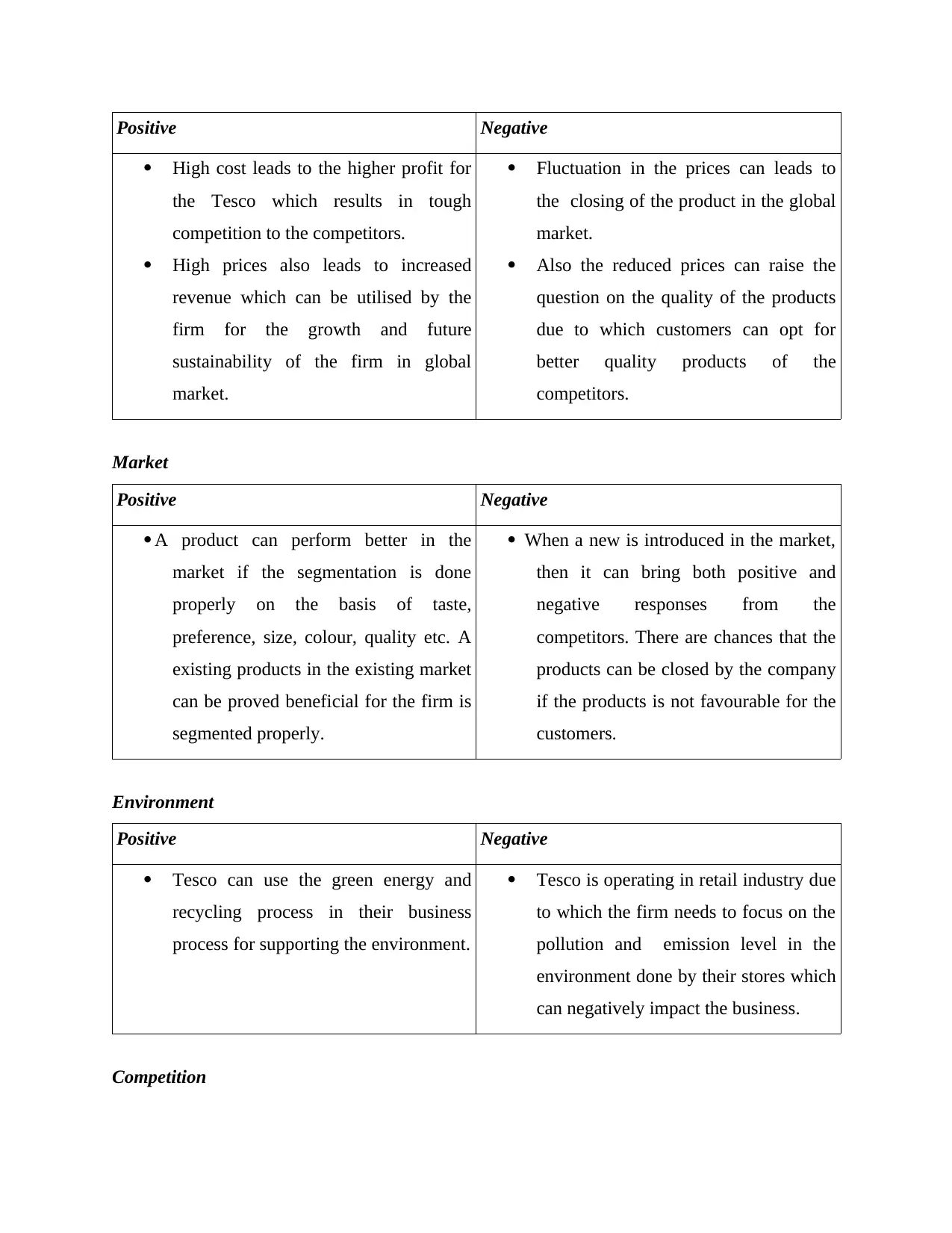
Positive Negative
High cost leads to the higher profit for
the Tesco which results in tough
competition to the competitors.
High prices also leads to increased
revenue which can be utilised by the
firm for the growth and future
sustainability of the firm in global
market.
Fluctuation in the prices can leads to
the closing of the product in the global
market.
Also the reduced prices can raise the
question on the quality of the products
due to which customers can opt for
better quality products of the
competitors.
Market
Positive Negative
A product can perform better in the
market if the segmentation is done
properly on the basis of taste,
preference, size, colour, quality etc. A
existing products in the existing market
can be proved beneficial for the firm is
segmented properly.
When a new is introduced in the market,
then it can bring both positive and
negative responses from the
competitors. There are chances that the
products can be closed by the company
if the products is not favourable for the
customers.
Environment
Positive Negative
Tesco can use the green energy and
recycling process in their business
process for supporting the environment.
Tesco is operating in retail industry due
to which the firm needs to focus on the
pollution and emission level in the
environment done by their stores which
can negatively impact the business.
Competition
High cost leads to the higher profit for
the Tesco which results in tough
competition to the competitors.
High prices also leads to increased
revenue which can be utilised by the
firm for the growth and future
sustainability of the firm in global
market.
Fluctuation in the prices can leads to
the closing of the product in the global
market.
Also the reduced prices can raise the
question on the quality of the products
due to which customers can opt for
better quality products of the
competitors.
Market
Positive Negative
A product can perform better in the
market if the segmentation is done
properly on the basis of taste,
preference, size, colour, quality etc. A
existing products in the existing market
can be proved beneficial for the firm is
segmented properly.
When a new is introduced in the market,
then it can bring both positive and
negative responses from the
competitors. There are chances that the
products can be closed by the company
if the products is not favourable for the
customers.
Environment
Positive Negative
Tesco can use the green energy and
recycling process in their business
process for supporting the environment.
Tesco is operating in retail industry due
to which the firm needs to focus on the
pollution and emission level in the
environment done by their stores which
can negatively impact the business.
Competition
⊘ This is a preview!⊘
Do you want full access?
Subscribe today to unlock all pages.

Trusted by 1+ million students worldwide
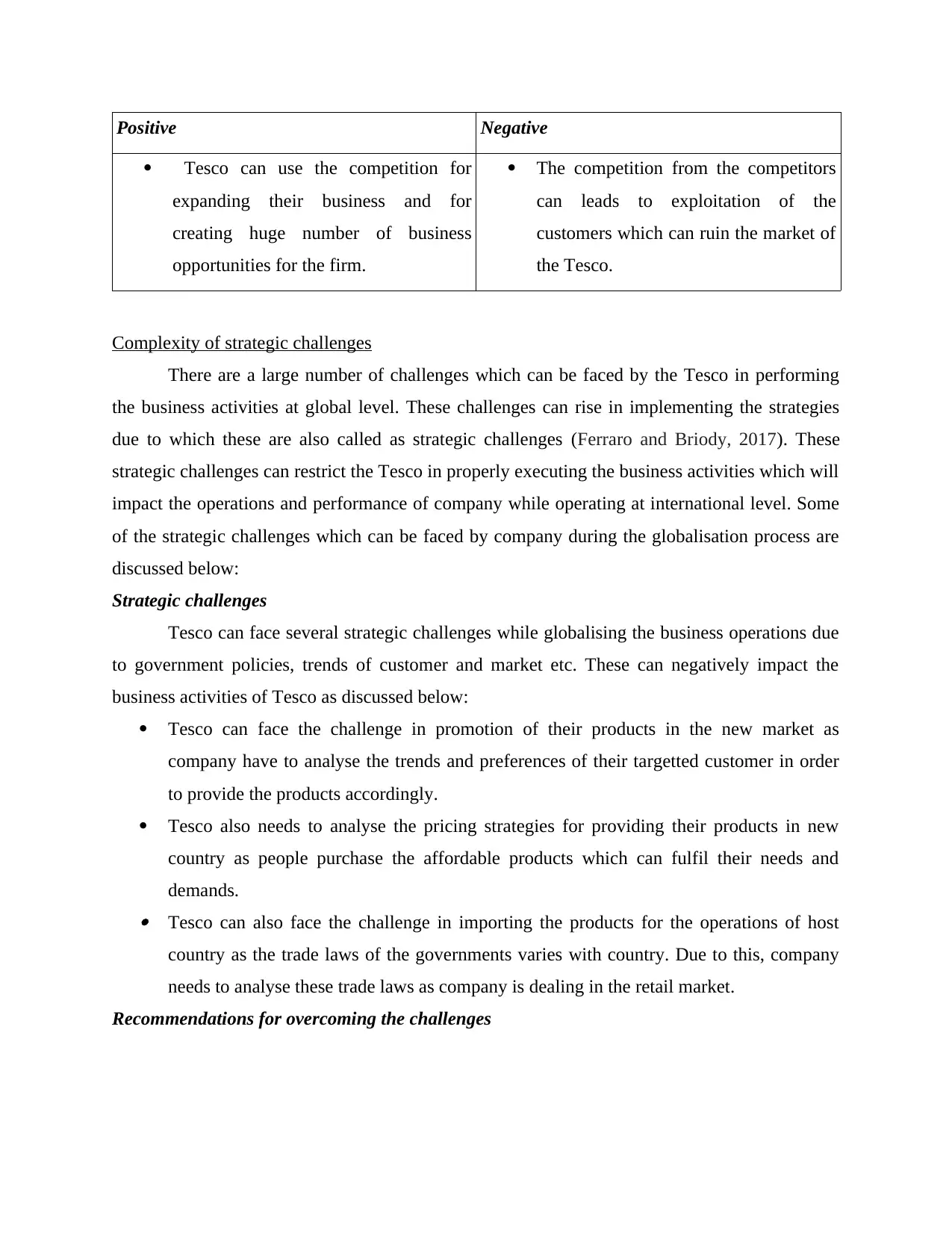
Positive Negative
Tesco can use the competition for
expanding their business and for
creating huge number of business
opportunities for the firm.
The competition from the competitors
can leads to exploitation of the
customers which can ruin the market of
the Tesco.
Complexity of strategic challenges
There are a large number of challenges which can be faced by the Tesco in performing
the business activities at global level. These challenges can rise in implementing the strategies
due to which these are also called as strategic challenges (Ferraro and Briody, 2017). These
strategic challenges can restrict the Tesco in properly executing the business activities which will
impact the operations and performance of company while operating at international level. Some
of the strategic challenges which can be faced by company during the globalisation process are
discussed below:
Strategic challenges
Tesco can face several strategic challenges while globalising the business operations due
to government policies, trends of customer and market etc. These can negatively impact the
business activities of Tesco as discussed below:
Tesco can face the challenge in promotion of their products in the new market as
company have to analyse the trends and preferences of their targetted customer in order
to provide the products accordingly.
Tesco also needs to analyse the pricing strategies for providing their products in new
country as people purchase the affordable products which can fulfil their needs and
demands. Tesco can also face the challenge in importing the products for the operations of host
country as the trade laws of the governments varies with country. Due to this, company
needs to analyse these trade laws as company is dealing in the retail market.
Recommendations for overcoming the challenges
Tesco can use the competition for
expanding their business and for
creating huge number of business
opportunities for the firm.
The competition from the competitors
can leads to exploitation of the
customers which can ruin the market of
the Tesco.
Complexity of strategic challenges
There are a large number of challenges which can be faced by the Tesco in performing
the business activities at global level. These challenges can rise in implementing the strategies
due to which these are also called as strategic challenges (Ferraro and Briody, 2017). These
strategic challenges can restrict the Tesco in properly executing the business activities which will
impact the operations and performance of company while operating at international level. Some
of the strategic challenges which can be faced by company during the globalisation process are
discussed below:
Strategic challenges
Tesco can face several strategic challenges while globalising the business operations due
to government policies, trends of customer and market etc. These can negatively impact the
business activities of Tesco as discussed below:
Tesco can face the challenge in promotion of their products in the new market as
company have to analyse the trends and preferences of their targetted customer in order
to provide the products accordingly.
Tesco also needs to analyse the pricing strategies for providing their products in new
country as people purchase the affordable products which can fulfil their needs and
demands. Tesco can also face the challenge in importing the products for the operations of host
country as the trade laws of the governments varies with country. Due to this, company
needs to analyse these trade laws as company is dealing in the retail market.
Recommendations for overcoming the challenges
Paraphrase This Document
Need a fresh take? Get an instant paraphrase of this document with our AI Paraphraser
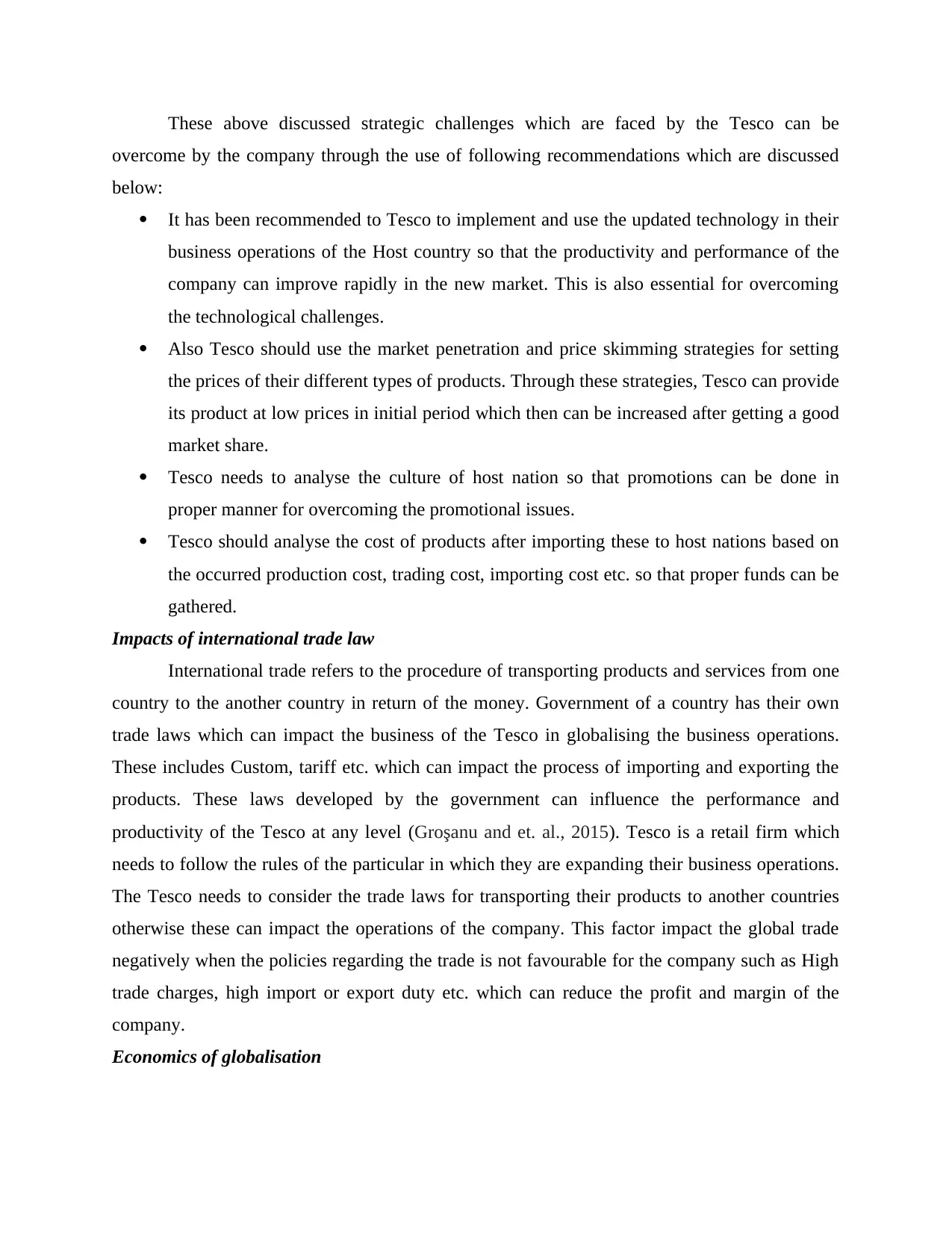
These above discussed strategic challenges which are faced by the Tesco can be
overcome by the company through the use of following recommendations which are discussed
below:
It has been recommended to Tesco to implement and use the updated technology in their
business operations of the Host country so that the productivity and performance of the
company can improve rapidly in the new market. This is also essential for overcoming
the technological challenges.
Also Tesco should use the market penetration and price skimming strategies for setting
the prices of their different types of products. Through these strategies, Tesco can provide
its product at low prices in initial period which then can be increased after getting a good
market share.
Tesco needs to analyse the culture of host nation so that promotions can be done in
proper manner for overcoming the promotional issues.
Tesco should analyse the cost of products after importing these to host nations based on
the occurred production cost, trading cost, importing cost etc. so that proper funds can be
gathered.
Impacts of international trade law
International trade refers to the procedure of transporting products and services from one
country to the another country in return of the money. Government of a country has their own
trade laws which can impact the business of the Tesco in globalising the business operations.
These includes Custom, tariff etc. which can impact the process of importing and exporting the
products. These laws developed by the government can influence the performance and
productivity of the Tesco at any level (Groşanu and et. al., 2015). Tesco is a retail firm which
needs to follow the rules of the particular in which they are expanding their business operations.
The Tesco needs to consider the trade laws for transporting their products to another countries
otherwise these can impact the operations of the company. This factor impact the global trade
negatively when the policies regarding the trade is not favourable for the company such as High
trade charges, high import or export duty etc. which can reduce the profit and margin of the
company.
Economics of globalisation
overcome by the company through the use of following recommendations which are discussed
below:
It has been recommended to Tesco to implement and use the updated technology in their
business operations of the Host country so that the productivity and performance of the
company can improve rapidly in the new market. This is also essential for overcoming
the technological challenges.
Also Tesco should use the market penetration and price skimming strategies for setting
the prices of their different types of products. Through these strategies, Tesco can provide
its product at low prices in initial period which then can be increased after getting a good
market share.
Tesco needs to analyse the culture of host nation so that promotions can be done in
proper manner for overcoming the promotional issues.
Tesco should analyse the cost of products after importing these to host nations based on
the occurred production cost, trading cost, importing cost etc. so that proper funds can be
gathered.
Impacts of international trade law
International trade refers to the procedure of transporting products and services from one
country to the another country in return of the money. Government of a country has their own
trade laws which can impact the business of the Tesco in globalising the business operations.
These includes Custom, tariff etc. which can impact the process of importing and exporting the
products. These laws developed by the government can influence the performance and
productivity of the Tesco at any level (Groşanu and et. al., 2015). Tesco is a retail firm which
needs to follow the rules of the particular in which they are expanding their business operations.
The Tesco needs to consider the trade laws for transporting their products to another countries
otherwise these can impact the operations of the company. This factor impact the global trade
negatively when the policies regarding the trade is not favourable for the company such as High
trade charges, high import or export duty etc. which can reduce the profit and margin of the
company.
Economics of globalisation
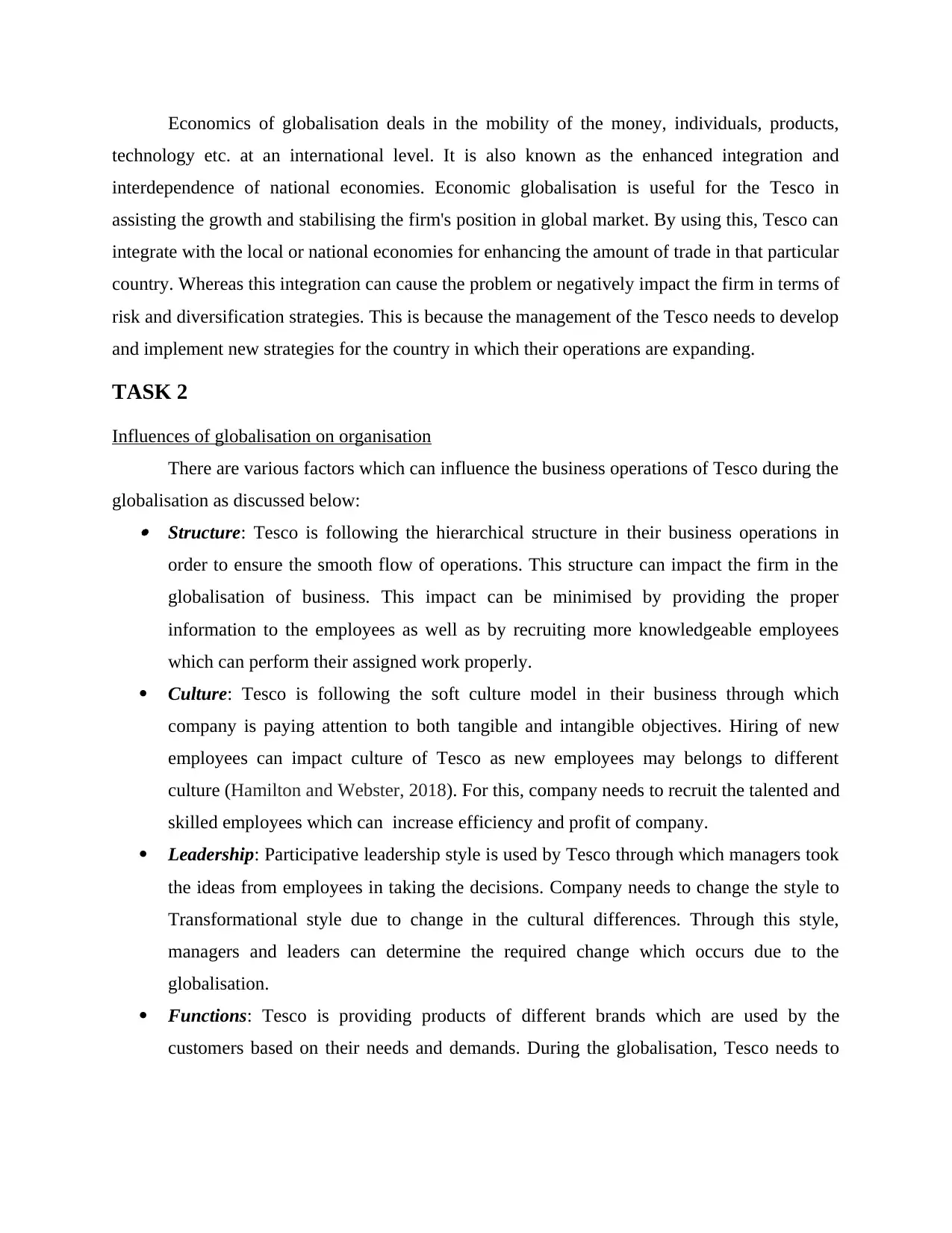
Economics of globalisation deals in the mobility of the money, individuals, products,
technology etc. at an international level. It is also known as the enhanced integration and
interdependence of national economies. Economic globalisation is useful for the Tesco in
assisting the growth and stabilising the firm's position in global market. By using this, Tesco can
integrate with the local or national economies for enhancing the amount of trade in that particular
country. Whereas this integration can cause the problem or negatively impact the firm in terms of
risk and diversification strategies. This is because the management of the Tesco needs to develop
and implement new strategies for the country in which their operations are expanding.
TASK 2
Influences of globalisation on organisation
There are various factors which can influence the business operations of Tesco during the
globalisation as discussed below: Structure: Tesco is following the hierarchical structure in their business operations in
order to ensure the smooth flow of operations. This structure can impact the firm in the
globalisation of business. This impact can be minimised by providing the proper
information to the employees as well as by recruiting more knowledgeable employees
which can perform their assigned work properly.
Culture: Tesco is following the soft culture model in their business through which
company is paying attention to both tangible and intangible objectives. Hiring of new
employees can impact culture of Tesco as new employees may belongs to different
culture (Hamilton and Webster, 2018). For this, company needs to recruit the talented and
skilled employees which can increase efficiency and profit of company.
Leadership: Participative leadership style is used by Tesco through which managers took
the ideas from employees in taking the decisions. Company needs to change the style to
Transformational style due to change in the cultural differences. Through this style,
managers and leaders can determine the required change which occurs due to the
globalisation.
Functions: Tesco is providing products of different brands which are used by the
customers based on their needs and demands. During the globalisation, Tesco needs to
technology etc. at an international level. It is also known as the enhanced integration and
interdependence of national economies. Economic globalisation is useful for the Tesco in
assisting the growth and stabilising the firm's position in global market. By using this, Tesco can
integrate with the local or national economies for enhancing the amount of trade in that particular
country. Whereas this integration can cause the problem or negatively impact the firm in terms of
risk and diversification strategies. This is because the management of the Tesco needs to develop
and implement new strategies for the country in which their operations are expanding.
TASK 2
Influences of globalisation on organisation
There are various factors which can influence the business operations of Tesco during the
globalisation as discussed below: Structure: Tesco is following the hierarchical structure in their business operations in
order to ensure the smooth flow of operations. This structure can impact the firm in the
globalisation of business. This impact can be minimised by providing the proper
information to the employees as well as by recruiting more knowledgeable employees
which can perform their assigned work properly.
Culture: Tesco is following the soft culture model in their business through which
company is paying attention to both tangible and intangible objectives. Hiring of new
employees can impact culture of Tesco as new employees may belongs to different
culture (Hamilton and Webster, 2018). For this, company needs to recruit the talented and
skilled employees which can increase efficiency and profit of company.
Leadership: Participative leadership style is used by Tesco through which managers took
the ideas from employees in taking the decisions. Company needs to change the style to
Transformational style due to change in the cultural differences. Through this style,
managers and leaders can determine the required change which occurs due to the
globalisation.
Functions: Tesco is providing products of different brands which are used by the
customers based on their needs and demands. During the globalisation, Tesco needs to
⊘ This is a preview!⊘
Do you want full access?
Subscribe today to unlock all pages.

Trusted by 1+ million students worldwide
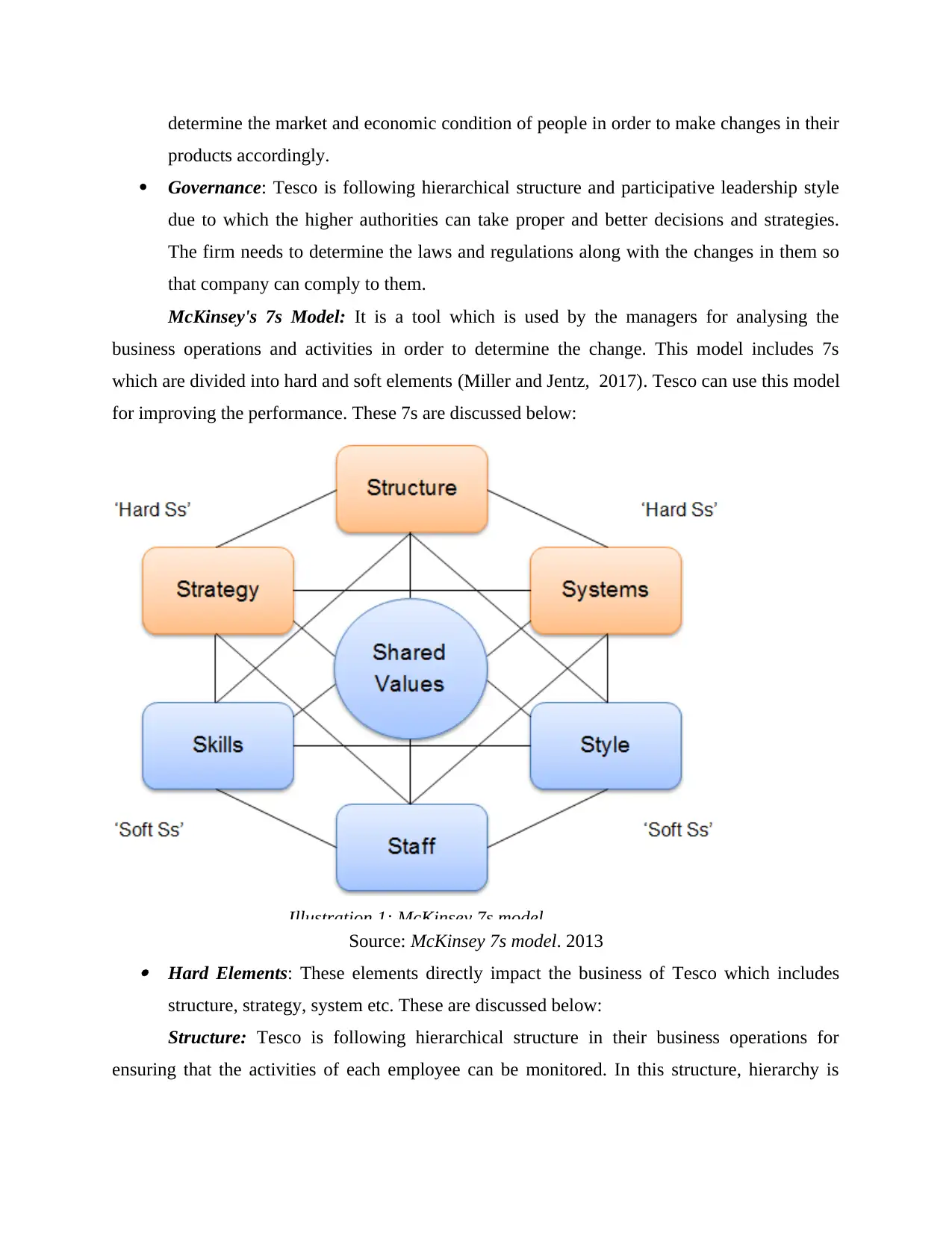
determine the market and economic condition of people in order to make changes in their
products accordingly.
Governance: Tesco is following hierarchical structure and participative leadership style
due to which the higher authorities can take proper and better decisions and strategies.
The firm needs to determine the laws and regulations along with the changes in them so
that company can comply to them.
McKinsey's 7s Model: It is a tool which is used by the managers for analysing the
business operations and activities in order to determine the change. This model includes 7s
which are divided into hard and soft elements (Miller and Jentz, 2017). Tesco can use this model
for improving the performance. These 7s are discussed below:
Illustration 1: McKinsey 7s model
Source: McKinsey 7s model. 2013 Hard Elements: These elements directly impact the business of Tesco which includes
structure, strategy, system etc. These are discussed below:
Structure: Tesco is following hierarchical structure in their business operations for
ensuring that the activities of each employee can be monitored. In this structure, hierarchy is
products accordingly.
Governance: Tesco is following hierarchical structure and participative leadership style
due to which the higher authorities can take proper and better decisions and strategies.
The firm needs to determine the laws and regulations along with the changes in them so
that company can comply to them.
McKinsey's 7s Model: It is a tool which is used by the managers for analysing the
business operations and activities in order to determine the change. This model includes 7s
which are divided into hard and soft elements (Miller and Jentz, 2017). Tesco can use this model
for improving the performance. These 7s are discussed below:
Illustration 1: McKinsey 7s model
Source: McKinsey 7s model. 2013 Hard Elements: These elements directly impact the business of Tesco which includes
structure, strategy, system etc. These are discussed below:
Structure: Tesco is following hierarchical structure in their business operations for
ensuring that the activities of each employee can be monitored. In this structure, hierarchy is
Paraphrase This Document
Need a fresh take? Get an instant paraphrase of this document with our AI Paraphraser
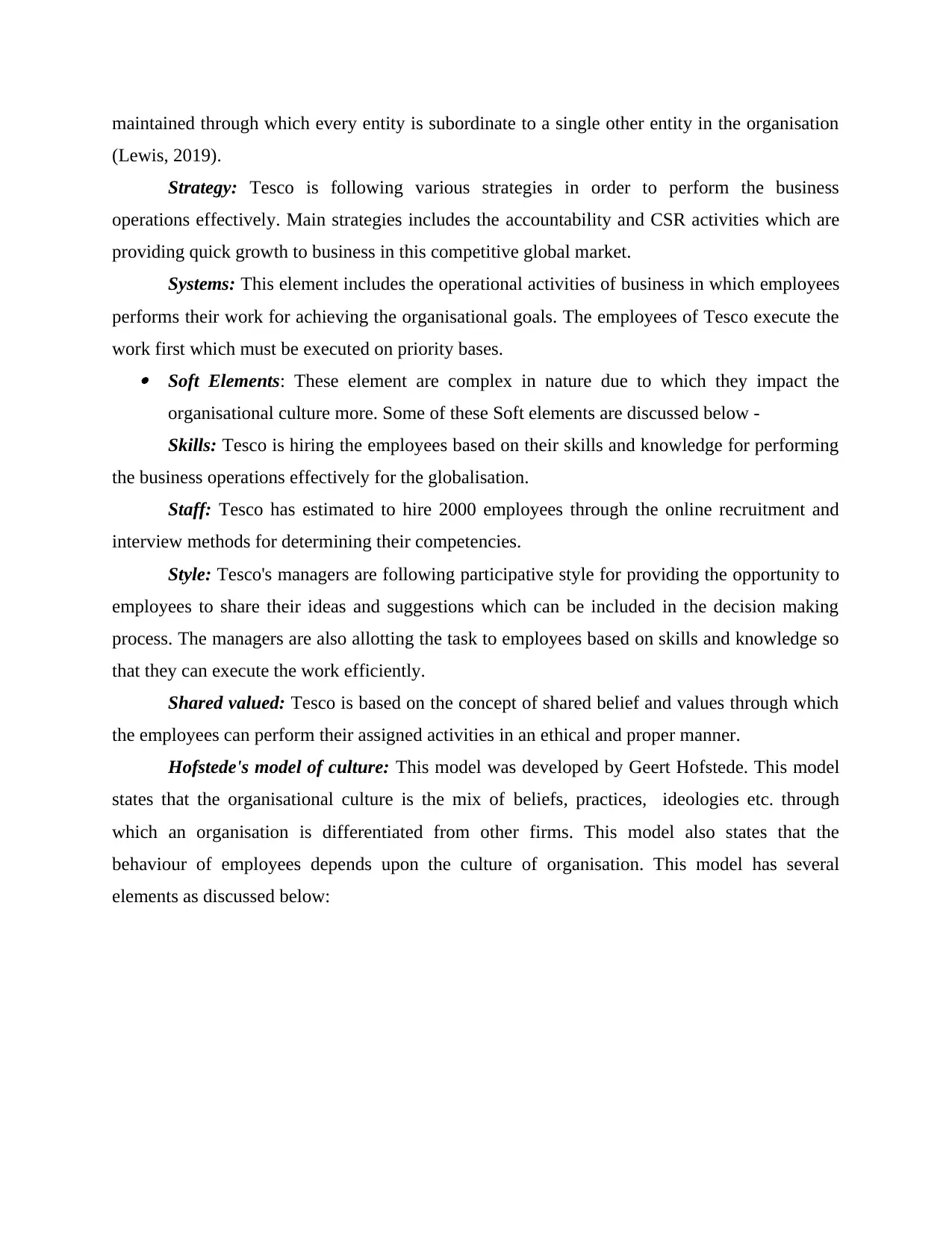
maintained through which every entity is subordinate to a single other entity in the organisation
(Lewis, 2019).
Strategy: Tesco is following various strategies in order to perform the business
operations effectively. Main strategies includes the accountability and CSR activities which are
providing quick growth to business in this competitive global market.
Systems: This element includes the operational activities of business in which employees
performs their work for achieving the organisational goals. The employees of Tesco execute the
work first which must be executed on priority bases. Soft Elements: These element are complex in nature due to which they impact the
organisational culture more. Some of these Soft elements are discussed below -
Skills: Tesco is hiring the employees based on their skills and knowledge for performing
the business operations effectively for the globalisation.
Staff: Tesco has estimated to hire 2000 employees through the online recruitment and
interview methods for determining their competencies.
Style: Tesco's managers are following participative style for providing the opportunity to
employees to share their ideas and suggestions which can be included in the decision making
process. The managers are also allotting the task to employees based on skills and knowledge so
that they can execute the work efficiently.
Shared valued: Tesco is based on the concept of shared belief and values through which
the employees can perform their assigned activities in an ethical and proper manner.
Hofstede's model of culture: This model was developed by Geert Hofstede. This model
states that the organisational culture is the mix of beliefs, practices, ideologies etc. through
which an organisation is differentiated from other firms. This model also states that the
behaviour of employees depends upon the culture of organisation. This model has several
elements as discussed below:
(Lewis, 2019).
Strategy: Tesco is following various strategies in order to perform the business
operations effectively. Main strategies includes the accountability and CSR activities which are
providing quick growth to business in this competitive global market.
Systems: This element includes the operational activities of business in which employees
performs their work for achieving the organisational goals. The employees of Tesco execute the
work first which must be executed on priority bases. Soft Elements: These element are complex in nature due to which they impact the
organisational culture more. Some of these Soft elements are discussed below -
Skills: Tesco is hiring the employees based on their skills and knowledge for performing
the business operations effectively for the globalisation.
Staff: Tesco has estimated to hire 2000 employees through the online recruitment and
interview methods for determining their competencies.
Style: Tesco's managers are following participative style for providing the opportunity to
employees to share their ideas and suggestions which can be included in the decision making
process. The managers are also allotting the task to employees based on skills and knowledge so
that they can execute the work efficiently.
Shared valued: Tesco is based on the concept of shared belief and values through which
the employees can perform their assigned activities in an ethical and proper manner.
Hofstede's model of culture: This model was developed by Geert Hofstede. This model
states that the organisational culture is the mix of beliefs, practices, ideologies etc. through
which an organisation is differentiated from other firms. This model also states that the
behaviour of employees depends upon the culture of organisation. This model has several
elements as discussed below:
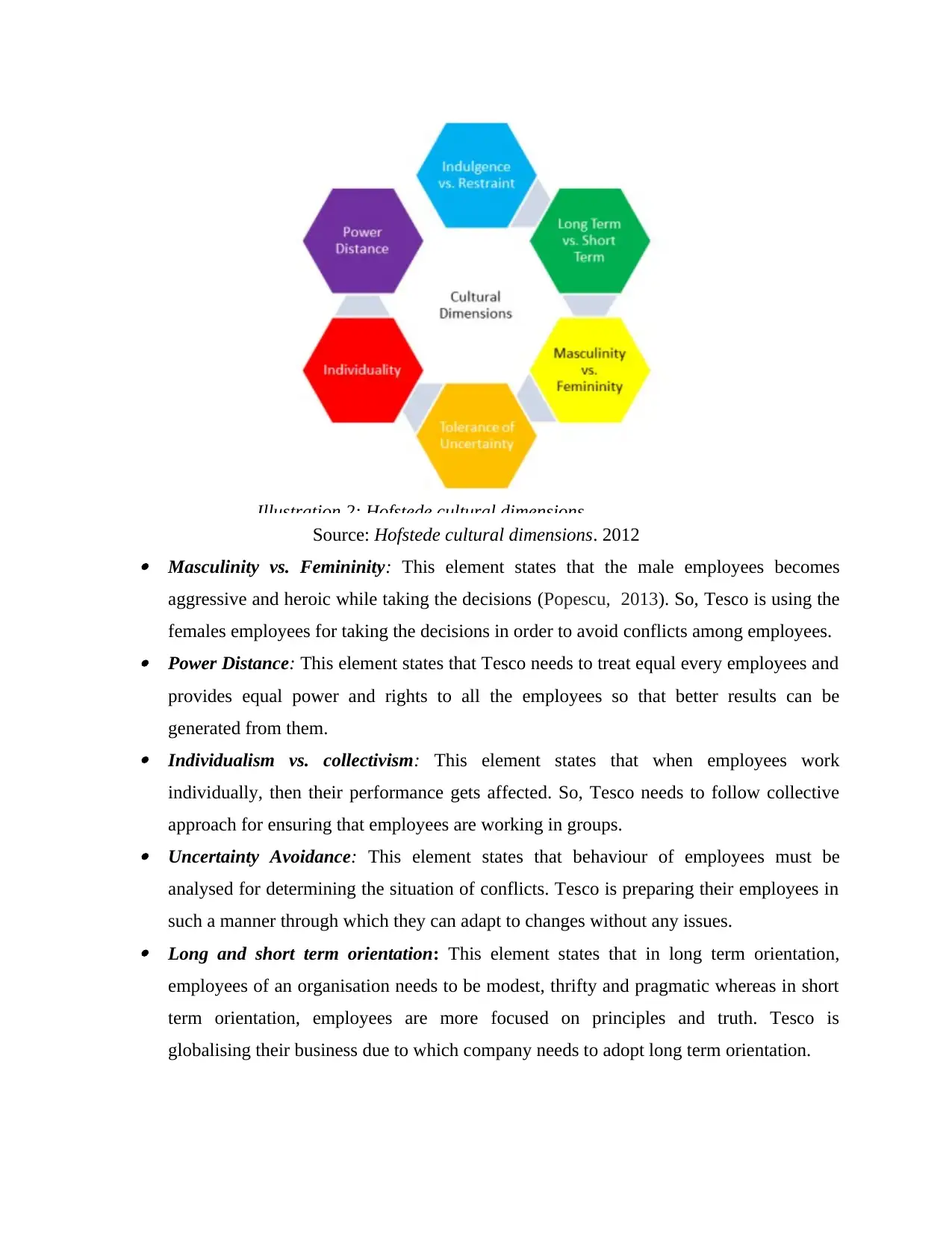
Illustration 2: Hofstede cultural dimensions
Source: Hofstede cultural dimensions. 2012 Masculinity vs. Femininity: This element states that the male employees becomes
aggressive and heroic while taking the decisions (Popescu, 2013). So, Tesco is using the
females employees for taking the decisions in order to avoid conflicts among employees. Power Distance: This element states that Tesco needs to treat equal every employees and
provides equal power and rights to all the employees so that better results can be
generated from them. Individualism vs. collectivism: This element states that when employees work
individually, then their performance gets affected. So, Tesco needs to follow collective
approach for ensuring that employees are working in groups. Uncertainty Avoidance: This element states that behaviour of employees must be
analysed for determining the situation of conflicts. Tesco is preparing their employees in
such a manner through which they can adapt to changes without any issues. Long and short term orientation: This element states that in long term orientation,
employees of an organisation needs to be modest, thrifty and pragmatic whereas in short
term orientation, employees are more focused on principles and truth. Tesco is
globalising their business due to which company needs to adopt long term orientation.
Source: Hofstede cultural dimensions. 2012 Masculinity vs. Femininity: This element states that the male employees becomes
aggressive and heroic while taking the decisions (Popescu, 2013). So, Tesco is using the
females employees for taking the decisions in order to avoid conflicts among employees. Power Distance: This element states that Tesco needs to treat equal every employees and
provides equal power and rights to all the employees so that better results can be
generated from them. Individualism vs. collectivism: This element states that when employees work
individually, then their performance gets affected. So, Tesco needs to follow collective
approach for ensuring that employees are working in groups. Uncertainty Avoidance: This element states that behaviour of employees must be
analysed for determining the situation of conflicts. Tesco is preparing their employees in
such a manner through which they can adapt to changes without any issues. Long and short term orientation: This element states that in long term orientation,
employees of an organisation needs to be modest, thrifty and pragmatic whereas in short
term orientation, employees are more focused on principles and truth. Tesco is
globalising their business due to which company needs to adopt long term orientation.
⊘ This is a preview!⊘
Do you want full access?
Subscribe today to unlock all pages.

Trusted by 1+ million students worldwide
1 out of 18
Related Documents
Your All-in-One AI-Powered Toolkit for Academic Success.
+13062052269
info@desklib.com
Available 24*7 on WhatsApp / Email
![[object Object]](/_next/static/media/star-bottom.7253800d.svg)
Unlock your academic potential
Copyright © 2020–2025 A2Z Services. All Rights Reserved. Developed and managed by ZUCOL.





